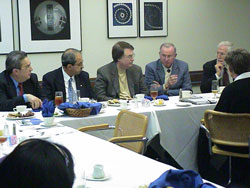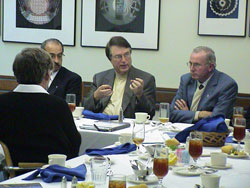Calit2 Discusses Collaboration with Mexican Science & Technology Leaders
1.26.2004 -- Calit² director Larry Smarr and SDSU professor of Geological Sciences Eric Frost met last week with leaders of Mexico's science and technology establishment as a first step in identifying projects of mutual interest as a foundation for more long-range collaboration. The Mexican delegation was led by:
 Felipe Rubio, director of Coordination of Groups and Centers of Investigation, CONACyT (Consejo Nacional de Ciencia y Tecnología, which translates as National Science and Technology Council, comparable to the National Science Foundation in the U.S.). Rubio is in charge of all research institutes in Mexico and all bi-national programs.
Felipe Rubio, director of Coordination of Groups and Centers of Investigation, CONACyT (Consejo Nacional de Ciencia y Tecnología, which translates as National Science and Technology Council, comparable to the National Science Foundation in the U.S.). Rubio is in charge of all research institutes in Mexico and all bi-national programs.
- Carlos Duarte, director of the CONACyT-U.S.A. project and sole CONACyT representative to the U.S.
- Javier Mendieta, director general of El Centro de Investigación Científica y de Educación Superior de Ensenada (CICESE), the largest of the Mexican research institutes and one that is closely connected with San Diego researchers.
The group affirmed that UCSD and Calit² will serve as one of the primary contacts. Projects that appeared to be of most interest to both parties included:
- Developing collaboration techniques and software, such as that demonstrated by Van Whiting, senior fellow at UCSD's Center for U.S.-Mexican Studies and director of the VirtualCal distance collaboration project. The Mexican VirtualCal team was represented at Friday's meeting by Raul Rivera and Jorge Preciado, and Lily Gomez participated in the afternoon from Ensenada, Mexico, using the VirtualCal system.
- Showing proof of concept applications for manufacturing, transportation, and border crossing for businesses and government groups from both countries.
- Developing emergency response applications using university researchers from both sides of the border to address environmental, sociological, and business problems, especially using telecommunications and sensor network technologies.
- Developing international applications for other countries in Asia, Europe, and Latin America where the best of both cultures, business, and research environments can be combined for mutual benefit.
- Ultra-high-resolution mapping of the Pacific coast (with involvement from researchers at the Scripps Institution of Oceanography and in conjunction with Canadians interested in this project). This project would leverage fiber-optic networking and sensors in the process of being deployed along the ocean floor.
- Educational exchanges (such as through Calit²'s summer undergraduate research scholarship program).
- Bilingual sharing of each other's materials (such as Spanish translation of Calit²'s Web site).
The visitors toured visualization centers at SDSU and UCSD's Scripps Institution of Oceanography. John Orcutt, Bill Hodgkiss, and Graham Kent participated at the SIO demonstration of onshore and offshore Baja California and discussed how major interaction could be done through SIO and CICESE on behalf of Calit² and CONACyT.
|
The group also toured Mike Bailey's visualization lab at the San Diego Supercomputer Center. Jay Dombrowski, SDSC chief engineer, hosted the group and provided significant support for the Virtual California videoconferencing demonstration.
Plans call for the U.S. team to make a "reverse" visit to CICESE in Ensenada in the spring to continue discussions about relevant projects and possible joint proposals that might be developed and submitted to both countries' national funding agencies to support the work suggested above.



